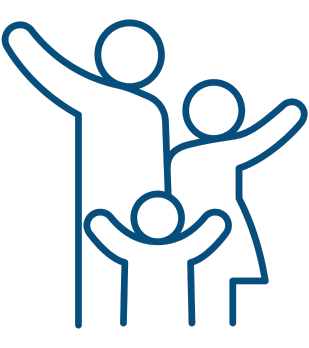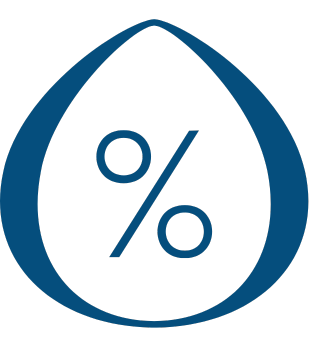Back pain is one of the most common health problems, which can occur at all stages of life and in different forms. Many people have experienced this problem at least once. Back pain often comes on suddenly, out of the blue, and sometimes it seems to have no real cause. Sudden back pain affects your whole quality of life, making it difficult to sleep, move or even sit still. The good news is that all types of back pain can be treated effectively. In this article, together with the Drops Clinic family clinic specialists, we will discuss why we sometimes get back pain, what causes back pain, how and by what symptoms it can be detected, and how we can get rid of the different types of back pain.
Our servicesCauses of back pain
Back pain can be caused by many different factors. The most common sources of back pain are problems in the spine, muscles, nerves or internal organs. Back pain is more likely to occur in people who are overweight, sedentary, with little or no physical activity. Back pain is also more likely to occur in people who are constantly under stress. In many cases, it is not possible to fully understand the causes of back pain. However, the following main causes can be identified:
- Sprains or injuries to muscles or ligaments;
- Injuries or herniations of the intervertebral discs of the spine;
- Nerve entrapment;
- Irregular position of legs and feet when walking, standing;
- Irregular posture when sitting or standing, lifting heavy objects;
- Anatomical changes (e.g. unequal leg length);
- Diseases of the spinal joints (e.g. osteochondrosis, osteoarthritis);
- Diseases of the abdominal organs (kidney, pancreas, gall bladder, etc.);
- Oncological diseases;
- Some infectious diseases;
- Menstruation, pregnancy.
Diagnosis of back pain
It is always important to seek medical advice if you experience acute back pain. Your doctor will assess your condition, your ability to move, stand and sit, and examine your back for injuries. The doctor may also ask you to describe the pain. After a routine examination, the doctor will determine the course of treatment for the pain, or, if the source of the pain is unclear, prescribe further tests.
To find out the possible causes of back pain, X-rays are usually taken to identify pathologies in the joints, vertebrae or discs. Blood or urine tests, ultrasound of the internal organs, gynaecological examinations, and other tests needed to investigate the internal factors of the body may also be prescribed. Sometimes a CT scan or MRI scan may also be ordered to examine the spine in more detail.
Lower back pain
Pain or soreness in the lower back, around the waist, is most often caused by trauma. However, pain can also be caused by various other health problems.
Pain in the lower back is most often felt on the right or left side, in the lower back near the waist. This pain is irregular and may recur after a certain period of time. Acute pain does not last more than 2-3 months. Chronic back pain lasts longer than 3 months.
Lower back pain is often exacerbated by prolonged sitting, bending over or lifting heavy objects, and sudden onset of back pain. Often, this back pain is accompanied by pain or numbness in the legs.
Pain in the lower back can be a symptom of a back muscle strain, a spinal hernia, arthritis or other spinal problems. Often lower back pain is caused by diseases of internal organs, such as kidney or bladder infections, or even menstruation.
Upper back pain
Upper back pain is not as common as neck pain, lower back pain or lumbar pain. This is because the bones and muscles in the upper back do not move and bend as much as those in the lower back.
Burning pain in the upper back is most often associated with strains or injuries in the neck and shoulder area and in the back muscles. Such pain can be caused by prolonged sitting at a computer, improper sitting or standing posture, stress or trauma. Therefore, upper back pain is more likely to occur in people who work in sedentary, strenuous jobs. Sometimes burning upper back pain is also caused by improper pillow or sleeping position.
The pain can spread from the neck to the shoulders and arms. Sometimes upper back pain is accompanied by headaches or dizziness.
Pain moving into the leg
Back pain that spreads to the leg is usually caused by a muscle strain, a spinal hernia or a pinched nerve. In this case, there may be a sharp or burning pain starting from the waist and spreading to the thigh, knee or calf. Sometimes numbness, tingling or weakness may be felt in the leg.
Sciatica, or a pinched nerve, is usually caused by poor posture, injuries or hernias. Most symptoms of sciatica improve over time because our nerves are resilient and in most cases any changes disappear, so the nerve recovers and the pain goes away on its own. However, it is best not to ignore back pain that moves to the leg and to see a doctor, as nerve pain in the back can also indicate a serious spinal problem, and waiting will only make the situation worse
Tips to prevent back pain
Back pain is an unpleasant problem that often affects your quality of life. It is therefore very important to take steps to prevent back pain, especially if you are more prone to back pain – if you work in a sedentary or strenuous job, if you do not move enough or if you are overweight. Here are some tips on how you can prevent back pain:
- Be physically active. Get moving every day – walking, swimming, jogging, exercising or any other activity you enjoy.
- If you are overweight, regulate your body weight. A good diet, work and rest regime is essential.
- Try to maintain good posture, especially when walking or sitting. Parents should teach their children correct posture from an early age.
- Choose ergonomic furniture and equipment for work and rest. Keep your back straight and keep your neck and shoulders in line when sitting.
- Use your legs and hips rather than your back when lifting heavy objects. When lifting objects, do not twist your body and avoid using your back.
- Avoid prolonged sitting or standing in one position. Periodically stand up and stretch.
- Sleep on a firm to medium mattress and a suitable pillow.
Treatment of back pain
Treatment of back pain depends on the nature, duration and intensity of the pain. The aim of treatment is to relieve pain, improve mobility and prevent recurrence. Sometimes back pain goes away on its own, but if the pain lasts for more than a month it is important to treat it.
The treatment of back pain can be varied and involve many different approaches. Back pain is treated with painkillers or anti-inflammatory drugs, physiotherapy, massage therapy, rest, warm and cold compresses. In extreme cases, surgery is needed. Each pain requires an individual approach, which is why a doctor’s consultation is important to determine the course of treatment.
Treatment of back pain with intravenous therapy
Intravenous therapy is also one of the treatments for back pain. This method is effective and is used when a person is in the centre of the worst pain and oral tablets do not give a sufficient result. Exercise and massage should be avoided when the pain is severe and only after it has subsided should the following preventive methods (sport, exercise, massage) be used. Intravenous therapy involves the administration of drugs directly into the bloodstream via a vein. This allows the drugs to reach the source of the pain more quickly and efficiently and reduces inflammation and muscle spasms.
Intravenous therapy helps to relax tight muscles, relieve pain and fight inflammation. Intravenous therapy ensures normal nerve cell metabolism
In most cases, a full course of intravenous therapy is given to treat back pain, with at least 3 repetitions needed, but if the pain is untreated and “neglected” it may take up to 7-10 times. Intravenous therapy should only be prescribed and administered by a qualified doctor and only after a thorough assessment of the patient’s condition.
The duration and frequency of therapy depends on the nature and intensity of the pain and the patient’s condition. Typically, therapy lasts from a few days to several weeks. Intravenous therapy can be combined with other treatment methods such as physiotherapy. The treatment can last from 30 minutes to 1.30 hours.
Our servicesBack pain is a common health problem that can arise from a variety of causes and manifest itself in different ways. Back pain can be acute or chronic, felt in the lower or upper back, and can sometimes spread to the leg or arm. The treatment of back pain depends on its cause and severity. Treatment may include medication, physiotherapy, massage or even surgery. People who work in sedentary or strenuous jobs, who move little or are overweight are more prone to back pain. It is therefore very important to stick to back pain prevention. To prevent back pain, it is important to be physically active, to choose the right furniture and equipment for work or rest, and to follow a correct posture and diet.
If you experience back pain, don’t hesitate to contact the expert team of doctors at Drops Clinic, who are always ready to help you regain your quality of life. Our team is staffed exclusively by professionals with exceptional skills and qualifications.




